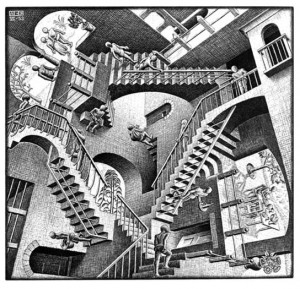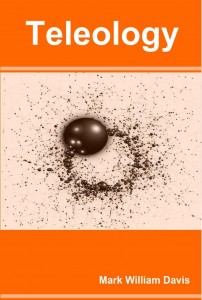He’s not backing down with his new book. Read/listen to his NPR interview.… Read the rest
Category: Philosophy
Arcosanti and Private Language
We (meaning my family) visited Paolo Soleri‘s Arcosanti in the high desert north of Phoenix today. Arcosanti is an attempt at an “arcology” meaning a dense urban structure that lives in harmony with the ecosystem around it. The term is a portmanteau of “architecture” and “ecology,” and the original motivator for the site was to prove that dense urban living without cars and yards could be ecologically sensible and could inspire a sense of connectedness and community that has been lost in the suburbanization of America.
The facility is both amazing in its vision and somewhat dated in its approach. The limitations arise from its beginnings in the 70s and the available technology at that time. Only recently have photovoltaic panels been introduced. There is no real exploitation of wind power. Food self-sufficiency is only beginning to be addressed with greenhouses. It’s no biotecture but, arguably, it is a primary intellectual bedrock for new urbanism and green building.
 We hiked out to the observation platform, we toured the ceramics facility and foundry, we bought bells and T-shirts, and I picked up a copy of Paolo Soleri: What If? Collected Writings 1986-2000.
We hiked out to the observation platform, we toured the ceramics facility and foundry, we bought bells and T-shirts, and I picked up a copy of Paolo Soleri: What If? Collected Writings 1986-2000.
It’s a flawed book filled with a unique form of craziness. I remember that Teilhard de Chardin-style abstract craziness from my late teenage years when I read Omega Seed, but early on in this new compendium there is an admission by the compiler that there very well may be a private aspect to the ideas that fuel the Soleri way of art that are inaccessible to rational thinking and imperfect in any linguistic rendering:
… Read the restFor the best artists, thought runs on a track alongside art and does not touch it, does not converge, leaving for the art the nondiscursive, the ineffable part that cannot be treated adequately by thought, by ratiocination.
Trust in What? Counterpoint
 Peter Berkowitz at Hoover Institute argues in Wall Street Journal that higher education is a liberal indoctrinating mechanism. The article centers on a report, available here, that looks at the University of California system.
Peter Berkowitz at Hoover Institute argues in Wall Street Journal that higher education is a liberal indoctrinating mechanism. The article centers on a report, available here, that looks at the University of California system.
There is not much new in the report. It repeats the mantra that core courses in Western Civilization are an essential and missing part of many educational curricula. It also rounds up the disturbing result that has been circulated for some time: it is difficult to assess the value of college educations. Quoting the report quoting studies of the efficacy of college:
We observe no statistically significant gains in critical thinking, complex reasoning, and writing skills for at least 45 percent of the students in our study.
That doesn’t surprise me, but I’m still not altogether certain that critical thinking can actually be taught despite efforts to try to do so in recent decades. More interesting, though, is the attempt by the authors to try to link this skills deficit to progressive political activism:
If graduates cannot even write short declarative sentences competently, that is not surprising when writing courses neglect writing and focus instead on radical politics. When graduates cannot read and extrapolate from books of any difficulty, that is what one would expect when reading lists so often give them books written at the superficial level of journalism rather than more complex works that would challenge them.
Let’s dissect. What do these imagined writing courses look like? Most low-level writing courses emphasize a variety of writing styles, but has the UC system substituted political activism for actual writing instruction? The report is rather vague about that, instead focusing on descriptions of how the professors made political statements and gave little writing advice, as reported by complaining students on a website.… Read the rest
Moral Adaptive Bridges
 The reviews of Jonathan Haidt’s new book, The Righteous Mind, have begun in earnest. William Saletan raises the implicit question embedded in Haidt’s objective stance: is reasoned consideration of moral questions an improvement over traditionalism? That is, even if we accept that moral intuitions are emotional and reactive, are we not better when we transcend those intuitions and rely instead on a rational calculus that carefully weighs the pros and cons of personal decisions and social policies?
The reviews of Jonathan Haidt’s new book, The Righteous Mind, have begun in earnest. William Saletan raises the implicit question embedded in Haidt’s objective stance: is reasoned consideration of moral questions an improvement over traditionalism? That is, even if we accept that moral intuitions are emotional and reactive, are we not better when we transcend those intuitions and rely instead on a rational calculus that carefully weighs the pros and cons of personal decisions and social policies?
A clear example is the changing perspective in America towards gay marriage. The issue serves as a proxy for the general acceptance of gays and lesbians in society. And, critically, it is at odds with Haidt’s dimensional characterization of the conservative mind as focusing on the sacrosanct while the liberal mind is focused on fairness and reason. Why is it at odds? Because public opinion has moved steadfastly towards acceptance over time. The influence of tradition and the sacrosanct appears to wane. We see this again and again in America; racism falls before the onslaught of reason, religious bigotry and anti-semitism dissolve into the background noise. What once was a source of moral revulsion is now justified as a source of moral standing.
How does change occur? We can invoke Sam Harris’ notion of The Moral Landscape to help understand the character of drift. Harris’ landscape is an abstraction of the notion of an adaptive landscape. In evolutionary change over multi-variate topographies, the primary problem that occurs is that of “local minima” (or, alternatively “local maxima”). That is, as species change in response to environmental signals, they become specialized in a very narrow niche. An alternative set of traits would yield better outcomes but, because they are well adapted to the local environment, they never jump out and discover the better set of traits.… Read the rest
Moral Feelings and Reactions
Nicholas Kristof at the New York Times rounds up the exceptional work of Jonathan Haidt and others in his opinion piece, here. In reading it, I was reminded of the complicated reactions I encountered to an opinion piece I authored in the local paper about five years ago.
I wrote the piece, titled “Scouts and the Constitution,” following helping neighbors develop a rousing audio-visual tribute to their son’s achievement of Eagle Scout status in the Boy Scouts of America. His journey was not without complications: the parents had misrepresented through omission certain moral failings of the boy, and the boy had, himself, some misgivings about the requirements that were involved in becoming an Eagle. Yet, they had all persevered through steadfast inertia and asked me to help put together a short video. It was not difficult, though I tried to point out that Steve Miller’s Fly Like an Eagle probably sends the wrong message on closer analysis (more on that in a moment).
We attended his Eagle event at a local church and I got to witness my video being used as part of the activities. The scout leader spent some time describing the number of local scouts who had moved on to military careers and how scouting prepared them for national service. But then he let slip that it was the conjunction of their religious commitment and scouting that made them especially suited to defend the US Constitution. I felt oddly hollowed out by that comment, though I myself have sworn that oath as part of joining the US Peace Corps several decades ago.
The problem that led to my editorial is that the US Constitution specifically calls out that there shall be no religious test for any elected position in the United States. … Read the rest
Poetry and Imprecision
 But what if the written word is not identifiably personal or about human relations? What if the ideas expressed in the texts don’t bind to any kind of honest analysis of the facts? What if the semantics are so diffuse that they are open to almost any interpretation?
But what if the written word is not identifiably personal or about human relations? What if the ideas expressed in the texts don’t bind to any kind of honest analysis of the facts? What if the semantics are so diffuse that they are open to almost any interpretation?
Then we have poetry.
On the Bay Area’s KQED Forum, Elaine Pagels talks about the Book of Revelation and her new book, its influence, misinterpretation, reinterpretation, and the scholarship that surrounds it.
Poetry is hidden and mystical. This makes it great in inspiring interpretation but also great in the breadth of the imaginable interpretations. Imprecision can inspire monumental achievements and horrific human tragedies–likely in about the same proportions. Luckily, we now have the power to parody and deconstruct it all without fear and with the building knowledge that through that deconstruction we can better account for an understanding of the humanity of others.… Read the rest
Fiction and Empathy
The New York Times reviews the neuroscience associated with reading fictional accounts, concluding that the brain states of readers show similar activation patterns to people experiencing the events described in the book. This, in turn, enhances and improves our own “theory of mind” about others when we read about social interactions:
[I]ndividuals who frequently read fiction seem to be better able to understand other people, empathize with them and see the world from their perspective. This relationship persisted even after the researchers accounted for the possibility that more empathetic individuals might prefer reading novels.
Steven Pinker’s The Better Angels of Our Nature suggests that the advent of the printing press is where we see the start of a shift in European societies’ attitudes about violence. The spread of reading and the growth of political satire correlate with reductions in state violence through the 19th Century and into the 20th (yes, he argues the 20th shows a reduction in violence, despite our intuitions about WWI and WWII). Think Voltaire. Think All Quiet on the Western Front.… Read the rest
Teleology, Chapter 26
 Wherein, the protagonist, Mikey, his twin brother, Harry, and a journalist, Jacob, are being physically healed by intelligent nanomachines while their consciousnesses are in a virtual world that appears to be a research ship in the Pacific Ocean.
Wherein, the protagonist, Mikey, his twin brother, Harry, and a journalist, Jacob, are being physically healed by intelligent nanomachines while their consciousnesses are in a virtual world that appears to be a research ship in the Pacific Ocean.
26
We hovered in our “matrix” of sorts for ten more days. The Lexis reported that the search by US military forces was intensifying. Swarms of unmanned underwater and airborne vehicles were scouring the sea, though the most intense efforts were concentrated several hundred kilometers from our new location. The Lexis believed that the platform was in jeopardy because of the new connectivity that they had achieved to the outside world through the control of the nanobots, but also seemed consigned to whatever fate I dictated concerning their disposition. I chose to wait because our medical conditions were improving day by day—at least according to them—and I saw no reason to emerge until maximally healed.
We relaxed aboard the Recherché in the meantime, eating Cottard’s increasingly elaborate cooking and drinking his exceptional wines. The wines and foods were all familiar to me, I realized; the sensations had been mined from our thoughts and recollections. There was something disturbing about that, though I didn’t feel particularly violated because the Lexis were both a familiar quantity to me and their motivations I suspected were not malevolent.
While waiting I worked with the Lexis to try to understand how they had taken command of the external nanomachines and how they had modified them to improve their functionality. They regarded the entire exercise as something like the Sistine Chapel ceiling. It was an elaborate artistic effort designed to promote the idea of the Creator among their kind by showing my adventures in an almost unimaginable heaven that they saw us living in.… Read the rest
Cosmologies and Theories of Everything
Zach, fictional though he is, is not the only one interested in cosmological theories. But what form do these theories take? A Theory of Everything or TOE is a theory that intends to explain the entire observable universe using a compact specification of equations and the conceptual arguments that support them. In the modern sense, a TOE is a physical explanation of the large-scale structure of the universe. Later, we can start to expand the TOE to look for “bridging laws” that help justify other phenomena that approach the human scale.
What are our alternatives? The previous post mentioned the Catholic Church’s embrace of Big Bang cosmology as justifying Genesis. Apologist and philosopher of religion William Lane Craig also elaborately evaluates Big Bang theories as substantiating theism by supporting creation at the singularity event.
But do these notions change the underlying TOEs? No, in general. The best that they can do is accept the TOE as an input and make a deductive argument based on assumptions that are not excluded by the TOE. For apologists, that means that the singularity event provides a divide between a non-temporal pre-universe and the current universe–effectively between non-existence and existence. But that is not the only TOE available to us. There are a range of TOEs that have been devised. The following is derived from Marcus Hutter’s A Complete Theory of Everything (Will Be Subjective):
- (G) Geocentric model: Ancient notion that the Earth is at the center of the known universe.
- (H) Heliocentric model: Evolution of the model to centralize on the Sun.
- (E) Effective theories: General relativity, quantum electrodynamics, and Newtonian mechanics, but without a unifying architecture.
- (P) Standard model of particle physics: Beginning of unification that contains numerous arbitrary parameters and has yet to unify gravity.
Cosmological Interregnum

Zach, the main character in Signals and Noise, finds himself fascinated by cosmology because it is the only thing that takes him outside of everyday reality into a realm that is alien and mysterious. Biology is reconcilable to our personal lives, law is a linguistic game, computer science is second-hand to Zach, the complex mathematics of the titular “Signal” is discoverable in intent if not details, but cosmology asks questions that cross into a metaphysical realm. Unlike religious feeling, however, there is no requirement of faith and no direct application to human interactions. There is no ethics of cosmology and little human history.
Should we have expected this? Should we have expected a universe that has black holes or neutrinos? We currently believe that the universe is expanding and may expand forever into a cold, diffuse conclusion. Dark matter and dark energy have to be invoked to explain this and the clumping we observe in the universe. But, interestingly, tiny little particles called neutrinos may be a large portion of this dark matter. Neutrinos have tiny mass and behave somewhat like photons passing through translucent materials when they pass through matter, but they change forms during transit according to an interesting interaction with matter known as “flavor oscillations.”
While the Catholic Church uses cosmology to justify ex nihilo creation, there is almost nothing in modern cosmology that justifies or supports religious sentiments, whether Western or Eastern. Indeed, this is just plain weird shit that devolves out of mathematical results and then is confirmed or denied by experimental methods (with a bias towards the confirmed results).
Zach is more than justified. He is right in his fascination and his skepticism about merely human ideologies.… Read the rest
